In just a few days – during the evening hours of August 12 and morning of August 13 – one of the year’s most reliable meteor showers is about to grace this year’s dark skies. Not only will we be in for some celestial fireworks, but the planets are going to put on a show as well. Who, what, when, where, why and how? Then step inside and let’s talk about the 2010 Perseid meteor shower…
During the latter half of July and the beginning of August, the Earth cruises through several minor cometary debris streams – producing equally minor meteor showers which meander through the constellations of Cygnus, Capricornus and Aquarius. This is the type of normal activity which is enjoyed by both the northern and southern hemisphere. One any given good, dark night, you might spot as many as a dozen meteors during an evening’s observing session. It’s a nice transition in the weather for both halves of Earth and this period of time makes for comfortable watching. While I love catching a sparkling trail when I really wasn’t expecting or waiting for one, there’s nothing in the heavens that can make me yell out loud like being witness to a productive meteor shower.
And the Perseids produce…
 Where exactly did all the “stuff” come from that causes the annual Perseid meteor shower to be so reliable? Try periodic comet 109P/Swift-Tuttle. Discovered in 1862, Swift-Tuttle is called “periodic” because it makes a pass through our solar system about every 133-135 years leaving behind a debris trail. As early as 36 AD, Chinese astronomers began to notice a sharp peak of meteor activity during this time and began keeping record. Other astronomers followed suit until astronomy became a rather dangerous occupation and facts and figures began to dwindle. Although often referred to as “the tears of St. Lawrence” to celebrate the martyr’s death on August 10, it wasn’t until 1835 and Adolphe Quetelet that the annual Perseid was actually given credit to an individual for pinpointing its radiant and peak date.
Where exactly did all the “stuff” come from that causes the annual Perseid meteor shower to be so reliable? Try periodic comet 109P/Swift-Tuttle. Discovered in 1862, Swift-Tuttle is called “periodic” because it makes a pass through our solar system about every 133-135 years leaving behind a debris trail. As early as 36 AD, Chinese astronomers began to notice a sharp peak of meteor activity during this time and began keeping record. Other astronomers followed suit until astronomy became a rather dangerous occupation and facts and figures began to dwindle. Although often referred to as “the tears of St. Lawrence” to celebrate the martyr’s death on August 10, it wasn’t until 1835 and Adolphe Quetelet that the annual Perseid was actually given credit to an individual for pinpointing its radiant and peak date.
Within four years, sharp-eyed observers had not only began to note the Perseid presence, but to make an accurate hourly account of the fall rate as well. In 1839, E. Heis gave us his first written documentation of a maximum rate of 160 per hour and over the next several decades, many other observers joined him. What they noticed through their observations was the fall rate changed from year to year… Why?
 Between 1864 and 1866, Giovanni Schiaparelli also took an interest in the Perseids and computed the stream’s orbit. What he discovered was astounding. It nearly matched that of a comet discovered just two years earlier – 109P/Swift-Tuttle. After that, it didn’t take very long to figure out each high spike in fall rates also corresponded with the comet’s known perihelion. It was the very first time a meteor shower had been positively identified with a comet!
Between 1864 and 1866, Giovanni Schiaparelli also took an interest in the Perseids and computed the stream’s orbit. What he discovered was astounding. It nearly matched that of a comet discovered just two years earlier – 109P/Swift-Tuttle. After that, it didn’t take very long to figure out each high spike in fall rates also corresponded with the comet’s known perihelion. It was the very first time a meteor shower had been positively identified with a comet!
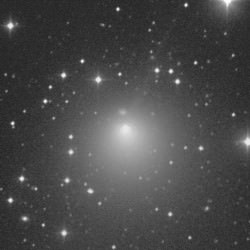 But, when it comes to science, proving a speculation is everything. Record keeping for that period of time wasn’t exactly the best and in 1973 astronomer Brian Marsden was busy trying to predict the return of comet Swift/Tuttle. His chosen date was 1981 and as annual activity of the Perseid meteor shower increased, so did the excitement of recapturing the comet. However, like so many astronomical predictions, the traveler from Oort Cloud failed to make its debut appearance Needless to say, between disappointment and lunar interference, interest in the Perseid’s cometary originator quickly faded. However, Marsden wasn’t about to give up. Choosing another documented comet seen in 1737, he made another prediction… Swift/Tuttle would return in 1992.
But, when it comes to science, proving a speculation is everything. Record keeping for that period of time wasn’t exactly the best and in 1973 astronomer Brian Marsden was busy trying to predict the return of comet Swift/Tuttle. His chosen date was 1981 and as annual activity of the Perseid meteor shower increased, so did the excitement of recapturing the comet. However, like so many astronomical predictions, the traveler from Oort Cloud failed to make its debut appearance Needless to say, between disappointment and lunar interference, interest in the Perseid’s cometary originator quickly faded. However, Marsden wasn’t about to give up. Choosing another documented comet seen in 1737, he made another prediction… Swift/Tuttle would return in 1992.
This time was sweet success.
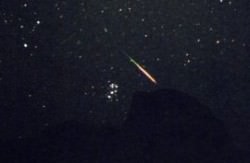 With 18 years between now and comet Swift/Tuttle’s last perihelion, will the 2010 Perseid meteor activity be a smashing shower or a dwindling display? It’s really hard to say because the stream is so wide and complex. We know when the Earth passes through this outgassing of materials that we can expect a certain amount of activity during a marginal time period – but we can only make a guess at how much material was expelled. There may have been time centuries ago when the comet did something very unexpected (as comets have a way of doing) and left a dense cloud just waiting for us to orbit through… And it may be burning itself out during each successive pass around Sol. So many things can happen! Jupiter may have affected the stream’s position – or a huge flurry of activity might occur during daylight. But what about this year?
With 18 years between now and comet Swift/Tuttle’s last perihelion, will the 2010 Perseid meteor activity be a smashing shower or a dwindling display? It’s really hard to say because the stream is so wide and complex. We know when the Earth passes through this outgassing of materials that we can expect a certain amount of activity during a marginal time period – but we can only make a guess at how much material was expelled. There may have been time centuries ago when the comet did something very unexpected (as comets have a way of doing) and left a dense cloud just waiting for us to orbit through… And it may be burning itself out during each successive pass around Sol. So many things can happen! Jupiter may have affected the stream’s position – or a huge flurry of activity might occur during daylight. But what about this year?
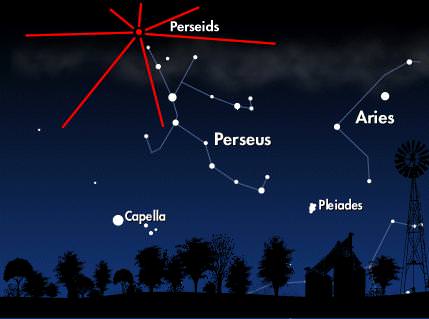 Thankfully there will be no Moon to obscure fainter meteors and zenith hourly rates may approach up to nearly 100 per hour. But that’s a very optimistic estimate since the Perseids are notoriously fast – burning through our atmosphere at 140,000 mph – and sometimes very faint. As the evening begins, facing east/northeast will be best for most northern hemisphere observers, and follow Perseus to the north as it rises. Unfortunately, southern hemisphere observers aren’t likely to see any of this activity – but it never hurts to keep watch to the northern horizon if you’re out. If you have to be selective about the times you watch, the very best views will be had when the constellation is at its highest – after local midnight through local dawn.
Thankfully there will be no Moon to obscure fainter meteors and zenith hourly rates may approach up to nearly 100 per hour. But that’s a very optimistic estimate since the Perseids are notoriously fast – burning through our atmosphere at 140,000 mph – and sometimes very faint. As the evening begins, facing east/northeast will be best for most northern hemisphere observers, and follow Perseus to the north as it rises. Unfortunately, southern hemisphere observers aren’t likely to see any of this activity – but it never hurts to keep watch to the northern horizon if you’re out. If you have to be selective about the times you watch, the very best views will be had when the constellation is at its highest – after local midnight through local dawn.
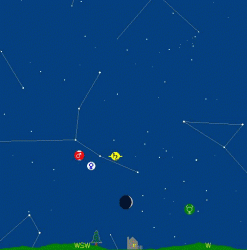 Don’t wait until the peak date to begin your observations. Perseid activity is already underway at 15 to 20 per hour and the fall rate will only continue to increase as it nears the night of August 12/13th when up to 75 meteors may grace the starry skies. If you live in a light polluted area, make plans to get rural. Many farmers and home owners in the countryside are more than happy to grant you permission to choose a safe observing spot on their land if you explain what you’re doing – so ask! Be sure to take along things which will aid in your comfort, such as a reclining lawn chair or blanket (meteor neck sucks). Make it a popcorn and soda family event! But stay away from white light. If being in the wild scares you a bit, create your own “night vision friendly” flashlight by stretching a red balloon over the lens. If you arrive at sunset? Then check out the beautiful conjunction of Mercury Mars, Saturn, Venus and the very tender crescent Moon….
Don’t wait until the peak date to begin your observations. Perseid activity is already underway at 15 to 20 per hour and the fall rate will only continue to increase as it nears the night of August 12/13th when up to 75 meteors may grace the starry skies. If you live in a light polluted area, make plans to get rural. Many farmers and home owners in the countryside are more than happy to grant you permission to choose a safe observing spot on their land if you explain what you’re doing – so ask! Be sure to take along things which will aid in your comfort, such as a reclining lawn chair or blanket (meteor neck sucks). Make it a popcorn and soda family event! But stay away from white light. If being in the wild scares you a bit, create your own “night vision friendly” flashlight by stretching a red balloon over the lens. If you arrive at sunset? Then check out the beautiful conjunction of Mercury Mars, Saturn, Venus and the very tender crescent Moon….
Wishing you clear skies and the very best of luck!
Here’s information on the 2009 Perseids.

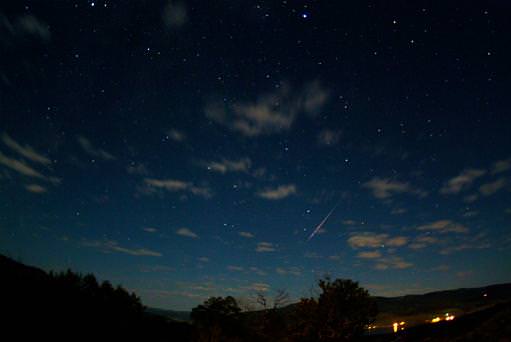
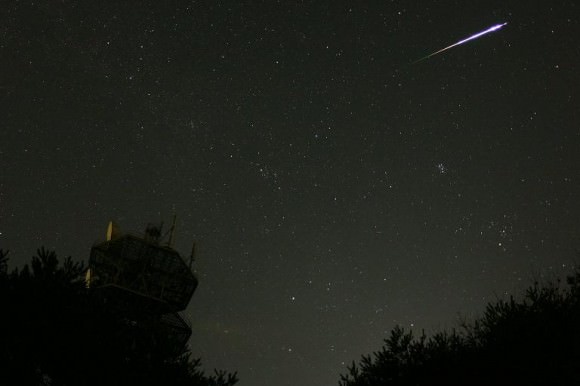
Aww, I have really bad light pollution where I live and I can’t exactly drive yet, so it looks like I’m gonna have to miss this shower 🙁
I had a few minutes to go outside and take a look for early Perseids last night. I wasn’t disappointed! After waiting about 5 minutes I was dazzled by a very bright Perseid crossing directly overhead! I LIKE!
Because activity is picking up, Whenever I’m on-line, I keep the radio meteor web page open in the BG.
http://topaz.streamguys.tv/~spaceweather/index.html
This is pretty awesome. I have my plans all made to go to a dark sky site around 2 hours away. I’ll probably go to sleep shortly after dark and then get up at like 2 or so to watch the meteors. This will also be my first time ever seeing the milky way, I’m just hoping a bunch of clouds don’t come along and foil my plans!
“Whenever I’m on-line, I keep the radio meteor web page open in the BG.
http://topaz.streamguys.tv/~spaceweather/index.html ”
I did the same thing yesterday watching the spacewalk. Interesting to hear a whistler while watching the ammonia ‘snow’-storm in LEO at certain points in the walk. If they weren’t so busy they may have caught a peek at one passing below. 😀
don’t forget that you can also “listen” by using an FM radio with an external antenna (even a car radio). just tune the lowest frequency that doesn’t carry a clear signal. any snatches of another station, a sharp uprise in static or curious “noise” are the signature sounds of a distant broadcast bouncing of a meteor’s ionized trail.
have fun!
For all those who cannot seen the shower for what ever reason do not despair.
We have a link on our web site to a UK meteor web site and with it Meteorwatch via Twitter is running.
We plan to live stream the shower given clear skies and following sea – so keep an eye on http://www.roselandobservatory.com
Hello all! I have a Canon DSLR and have begun playing around with taking images of the evening sky. Luckfully, I am blessed with dark skies and would love to shoot some of the Perseids but I have no expreience shooting meteors. Does anyone have suggestions or websites with information on the topic? For the time being, I am planning on attaching it to my telescope and program it up to shoot 10 consecutive 30 second exposures. I figure if I repeat that process I am bound to catch atleast one.
A few weeks ago, I happened to see a rather bright meteor in my binoclars. It just happened to go through my field of view. Pretty neat.
I hope the high humidity in my region doesn’t put a damper on things.
Yesterday, i’ve seen about 4 or 5 of them in an hour (i’m not sure about one, because it was really off in Bootes), but what is amazing – 2 bolides 10 minutes apart. And they were insanely fast. And a thing i’ve never seen before – one of the bolides left a wobbly path, like crappy chineese rocket on new year’s celebration.
So, is this normal, or we are about to see really exceptional Perseids this year?
@Renoor – As Tammy mentioned, anything can happen! That’s what’s so fun about meteor showers – the unexpected! “…left a wobbly path…” That one sounds like it might have been obround and aerodynamically tumbling along its path?
My favorites are the ones that leave a lingering trail behind. Sometimes those trails can last/be seen for upwards of a minute or so!
@Geology-
Taking multiple 30 second exposures sounds like a good strategy(coupled with a fast ISO). If your using a wide angle or standard 50mm lens, just mounting the camera on a tripod should give you non-trailed stars with 30-second exposures. Just be prepared to take a lot of exposures and don’t forget to periodically check your lens for dew buildup. Jerry Lodriguss has a page on meteor photography with a DSLR: http://www.astropix.com/HTML/I_ASTROP/TRIPOD/TRIPOD6.HTM
Clear skies and good luck! 🙂
although the zero hour isn’t exactly the best time to start practicing meteor photography, i surely can’t fault you because i’ve done astrophotography at the last second, too!
my suggestion would be to try circumpolar. aim your camera as true north as possible and take different sequences of different timed exposures. i have no idea as to how long the exposure should be – but i do know that since the constellation of perseus is darn near circumpolar that you’re going to stand a good chance. your result should look like a series of circles (the star trails) around a central point – and the meteors will be diagonal slashes through them.
best of luck!!
Geology
As a semi-professional amateur astronomer for many years, a college instructor of the subject, and an artist of the night and day sky, I have taken award winning and published time exposures of the night sky since I was a teen with the old world of wet film based cameras (feel free to see > http://www.markseibold.com
but more recently I have returned to my large pastel sketch art that is featured often in NASA sites, Spaceweather.com and once in Astronomy Picture of the Day. Others have offered very good advice (I thought at first you’d made the mistake of attaching your camera to photograph “through” the telescope. I would add that you not limit yourself to necessarily tracking the sky with a motor drive but then i realize you are limited to only 30 seconds max shutter speed with a newer DSLR. Of course many of us have now left behind the old world of film photography that allowed the ease of exposures up to many hours if desired. That can all still be done with a DSLR but there is much required work in Photoshop or other software to assemble and stack the many smaller 30 second images. The problem with limiting to only broken 30 second images is that every time you reset the camera to start again, you are likely to miss a really big fireball. This is why so many serious astronomer-astrophotographers now shoot high speed videos rather than still shots. many will forget that their newer DSLR’s like your Cannon also has the capability of video motion filming (with a larger memory chip advised, and this is more likely to capture many more meteors. Making note while you watch simultaneously, It is then a process to edit later and find the many meteors in real motion film frames. It is not as detailed in memory as the still shots but you are more likely to capture many more meteor streaking this way. Ideally, you would want to have more than one camera set up. One for video motion and one for still shots. Ask other friends to attend with you as more that use or assist in filming, the more likely you are to capture something.
Furthermore, you want to use the widest angle lens as possible as the meteors can occur anywhere across the sky.
Tammy Plotner offered good advice about aiming for a circumpolar image in time exposure but your DSLR will have to make many 30 second exposures to capture and assemble an image like my flagship award winner from 1994 that has received so much attention. > http://www.cloudynights.com/photopost/showphoto.php?photo=14435&size=big&password=&sort=2&thecat=500
*There are mostly my artworks in this gallery linked above but this one link shows that award winner that was taken with my (now 35 year old) 35mm Mamiya Sekor 1000DTL camera in 1994 at the Oregon Star Party. Note that I also like to include some night landscape on the ground and that I photoflash this in the final moments of the time exposure. This helps to add to your images as if they were to become Van Gogh Starry Nights paintings. [Just my two-thousands sense worth here.]
Perseus will be up at about 45 degrees high in the northeast sky at late evening now in mid August and to capture the “radiant point” for dramatic effect, you’ll want at least an equivalent 28mm lens or wider to achieve this. You want to include as much sky as your widest angle lens possibly allows.
Remember to set your ISO speed for 400 or higher [although this will increase the appearance of “grain” in your images, that can be slightly cleaned up later in Photoshop or other software.]
Good luck and enjoy your outing under the falling stars!
Mark Seibold, Retired IT Tech, Artist-Astronomy Educator, Portland Oregon
Got out for an hour last night, 24 hours before peak. Got a good rate of about 20 per hour (plus 2 erratics), with 4 really spectacular meteors, 1 producing sound. Most of them where very dim but well worth for those four. Hoping for clear skies tonight.
Thanks for all the advice. I will probably begin shooting 30 second exposures with fully opened aperture, 18mm focal length and cranked ISO (1600) for a couple of hours. Then attempt some 1-2 hour circumpolar shots for the rest of the evening. I figure an hour will give enough time for stars to trail a little and get at least a few meteors in frame. Plus, more than an hour or two would make for shooting dark frames until noon Friday. Once again, Thanks to all for the advice and web links. I wish you all clear skies tonight.